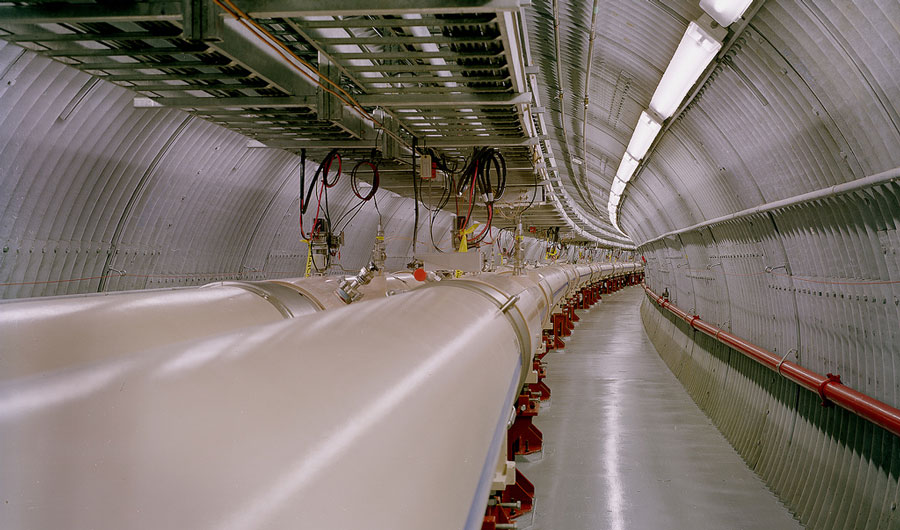Primordial particle soup smashes spin-speed record

The Relativistic Heavy Ion Collider of Brookhaven National Laboratory on Long Island, New York.
Brookhaven National Laboratory
(Inside Science) -- The particles in your body, the device you’re reading this on and everything else around you once swam in a primordial soup that existed just after the universe came into being. This bizarre fluid is the hottest, densest and freest-flowing substance ever known to exist. And the physicists who recreated it believe it can claim a new record: fastest-spinning.
For a few thousandths of a second after the Big Bang, elementary particles called quarks and gluons zipped about in a cosmic free-for-all. As the universe expanded and cooled, this plasma quickly froze into protons and neutrons, each of which contain three quarks held together by gluons. These particles make up the bulk of atomic matter that we know today.
“In a sense, all of us are made from the ashes of quark-gluon plasma,” said Ulrich Heinz, a theoretical physicist at Ohio State University in Columbus, “and it has never been observed again.”
But in the past decade, physicists have used massive machines to fleetingly resurrect the primordial plasma. In the Relativistic Heavy Ion Collider at the Brookhaven National Laboratory on Long Island, New York, powerful superconducting magnets accelerate electrically charged gold atoms in 2.4-mile-long rings to up to just 5 thousandths of a percent less than the speed of light. The high-speed atoms smash together with such force that they briefly turn into tiny amounts of the early universe’s superheated soup.
Directly probing these microscopic, short-lived plasma droplets is impossible. But STAR, a detector the size of a house, catches particles that stream away as the plasma cools and condenses. From the detector data, physicists can estimate properties such as the plasma’s temperature and density.
In 2007, Michael Lisa, a physicist at Ohio State, and colleagues attempted to measure another property called polarization, which quantifies the direction that certain particles produced by the plasma point. A polarized plasma would lead to particles streaming out from the collision site at specific angles. By measuring these particles, the researchers found no statistically significant net polarization in the plasma.
Most physicists lost interest in plasma polarization and moved on to other things, but Lisa persisted. He and graduate student Isaac Upsal continued analyzing data collected at lower collision energies, and used increasingly precise methods. They also became aware of calculations suggesting that when two atoms collide off-center, they could set off tiny spinning whirlpools in the resulting plasma, and these vortices could cause plasma-produced particles to polarize. Therefore, a measure of polarization would yield information about vorticity.
Lisa and his team analyzed the directions of exiting protons to estimate the plasma’s total vorticity. “We said, we have this data, we believe we can make this measurement; let’s try it,” Lisa said. “For about a year we did not find something; we spent the next year being sure we had found something -- you don’t want to publish something and be wrong, as an experimentalist -- and then the year after that we spent refining the message.”
The team found the plasma’s vorticity to be not zero, but around a dizzying billion trillion (10 multiplied by itself 21 times) rotations per seconds -- roughly a million billion (10 to the 15th power) times greater than that of the fastest-spinning fluids ever created in a lab. Lisa, Upsal and their roughly 600 STAR collaboration colleagues report their results today in Nature.
“This vorticity is really amazingly high,” said Francesco Becattini, a physicist at the University of Florence in Italy who did some of the calculations that motivated Lisa’s study. “This is really the first positive evidence of this phenomenon.”
The STAR team’s finding “is a groundbreaking result,” said Heinz, who is not on the experimental team but learned of the finding in February at a scientific meeting. “It has already had a huge impact on the theoretical community.” Previously Heinz and others had theorized that the plasma’s vorticity would be zero or very small. He and a student are now revising their calculations to explain the unexpectedly large value.
Among Lisa’s next steps is measuring the quark-gluon plasma’s magnetic field, which could break yet another record. He also hopes to shed light on the strong force, which governs how quarks and gluons behave. The strong force, one of the four fundamental forces alongside gravity, electromagnetism and the weak force, is responsible for the existence of atoms and the fusion reactions that power the sun.
“If you want to understand the nature of matter, you really have to understand the strong force,” Lisa said. “Unfortunately it is a very complicated force.”
Editor's note (August 7, 2017): The description of Michael Lisa's 2007 research on vorticity and polarization has been revised for clarity and accuracy.

